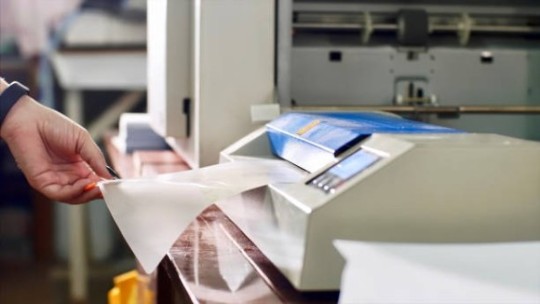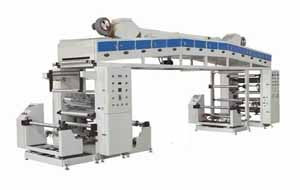#laminating machine
Explore tagged Tumblr posts
Text
How to Choose the Best Laminating Machine

Laminating machines are used in many industries for everything from manufacturing to stationary. Packaging materials such as cement bags are typically laminated, while stationary items require a laminating machine. You might have noticed local stationary stores that offer laminating that allow customers to have their college degrees as well as other important documents laminated to ensure they don't become damaged by the weather or other natural causes.
So, if you're looking to purchase a laminating device for your stationary business or to laminate your product like bags, bags, etc. you'll have to learn about some laminating machines and how to buy them. Therefore, this article is an essential guide for anyone who is considering buying a laminating machine who are confused on how to get the right machine.
What are Laminating Machines?
Large and small laminating machines can be used to laminate large or small items. This shields the object from any external environment. Some common examples include filled bags or paper that are laminated to increase their strength. For instance, a wheat grain bag or flour bag is often laminated by the bag maker, so the flour doesn't leak out and the bag stays solid. This is the appeal of laminating equipment.
How to Purchase Laminating Machines
In order to choose the best laminating machine that is right for you There are a lot of factors to consider. Here are a few examples. Assume that you are purchasing the laminating equipment to laminate paper.
1. Size of the input
If you're looking to purchase laminating equipment, you should make sure you choose the biggest paper feed size. The most popular size of laminating machine is A4, however if you want to laminate larger sizes of paper like A3, A2, or A1 it will cost more money. The machines also take up more space.
2. Warm Up And Preheat Speeds
Laminating machines must be heated up prior to making use of it. The laminator laminates paper using heat. The heat melts the plastic, and the roller presses it down to allow it to bond. The melting of the plastic requires heating up the laminator. Different laminators come with different warm up and preheat speeds. Find out which one best suits your requirements.
3. Lamination Speed
youtube
The rate at which paper is laid down, inserted and then released is called the speed of lamination. This is determined after subtracting the preheat and time to warm up. Laminators are able to laminate only several pages at a time. The speed is counted by lamination papers per minute (PPM).
4. Quick Jam Release
If the paper gets jammed halfway through lamination, some laminators have the option to let go of the jammed paper. This can also increase the total cost of laminators. Think about whether you actually require this feature and whether it is worth the investment.
Conclusion
Now that you've understood what features to look for in laminators, the following thing to do is buy one.The world today relies on China to acquire technology. Many well-known brands in the world have outsourced technical products to Chinese producers. It's possible to do similar.
0 notes
Note
Just cute Lamine yamal x girlfriend!reader fluff pls
In Your Arms — Lamine Yamal.

Pairing: Lamine Yamal x Fem!Reader
Summary: You have a stuffed animal he hadn’t noticed before, and the moment he spots it, playful teasing follows.
Word Count: 420+
Disclaimer/s — Fluff!
A/N: Super short, but! This makes me ill, so… thank.

Peaceful. This moment right here was peaceful.
You and your boyfriend were lying in bed. His head rested on your lap while you both watched a movie on your TV. However, you found more joy in gently tracing your fingers down his face. Starting at the bridge of his nose, moving down to his jawline, and up to his ears. Then repeating the soothing motion all over again.
Saying you were content would probably just be putting it mildly. An understatement.
It seems you’ve spoken way too soon at the sight of him shifting slightly. His eyebrows furrow in confusion when he feels something near his hip. Lifting his arm, he shuffles it under the blanket and pulls out something that quite literally makes you flush in complete and utter embarrassment.
“What’s this?” He asked, his smile melding into a smirk. “I didn’t know you had a stuffed animal.”
You tried to play it off. “Who doesn’t?”
“I don’t.” Oh, right. Right, of course. Awkward.
“Well... everyone's different,” you replied with a shrug of your shoulders. All he does is laugh in response, causing your eyes to narrow.
“Hm. Yeah, yeah, everyone is,” the boy muttered. “Let me ask you this: how old are you?”
Your eyes widen at that, and you reach forward to snatch the blue stuffed bunny out from his hands, your face flushing even more. “I think I might have to break up with you after that, not kidding.”
Lamine’s eyebrows pinch together, slowly using his elbow to prop himself up. “What? Uh, no.”
“Uh, yes,” a pause, “Jerk.”
“No—hey, I love you, and I love...” he trailed off, looking at you expectantly. You realized what it was he was wanting you to say.
“Oh! I don’t know. It changes, like, everyday.”
He nods, “Well, I love… it?”
“You’re so only saying that because you don’t want to end up single.” You giggled softly, but all he did was huff and snatch the bunny back into his grasp. Resting his head back onto your lap, he looked over at the TV, his fingers subconsciously messing with the animal’s arms and legs, the sight making your heart flutter in your chest. So, leaning down, you placed a small kiss to the edge of his eyebrow, that being the only place you could really reach. “Hey, okay, I love you, too.”
His triumph was clear, “You’re just saying that because you thought I was being serious.”
“Do you actually want to be single, let me know.”
“No!” He quickly replies, “I love you.”

Likes, reblogs, and comments are always appreciated ^_^.
DT(s) — @pedrilcvr ! ౨ৎ
#lamine yamal#lamine yamal x reader#lamine yamal x fem!reader#lamine yamal x you#lamine yamal x y/n#lamine yamal fluff#lamine yamal blurb#lamine yamal fic#fc barcelona#request#jilval#in your arms - sunbeam sound machine
251 notes
·
View notes
Text
breaking bad au but it's walter whitified minerva mcgonagall and her protégé (+former student) barty crouch jr
#this is from the drafts#what do u all know about minnie who dedicated her life to her role as chemistry teacher in one of em#super private high schools with a student body consisting of congressmen children#which barty ofc attended at his dad's behest#then proceeds to witness her own moral compass spin a gradual 180#anyways jesse pinkman barty but also not because he's just a dirtbag prodigy who missed out on being valedictorian#bc he was running a fake ID shop with a laminating machine he swiped from the sheriff station after getting bailed out by his father dear#true to creed fashion#barty is playing the kodak black x sweater weather mashup in his 2002 honda accord with 80k of drug sale profit in his lap
29 notes
·
View notes
Text

hyunjin on bubble: ta-da
#hyunjin#skz#🧼#MI BEBEEEEEEEEE 🥹😭❤️#lil dimple as a reward <3#he looks like some kind of bird with his hair spiking out#or like those dinosaurs with spikes on their backs. rawr = ilu in dinosaur#maybe i will make him a comfy nest . it’s just an instinct i am having rn#i need to be put through one of those lamination machines i think. he’s so cute#papers get stronger that way so maybe i will too
255 notes
·
View notes
Note
fuck. seeing u make all these cute charms and stickers makes me wanna make some too

join me brother. vograce is great for its low costs, low MOQ, and variety of diverse cute trinkets you can make for yourself and share with others
#ask#as for stickers i diy them at home bc i have sticker paper lamination/glitter lamination and a sticker cutting machine LMAO#IT'S BEEN 3000 YEARS MAN HOPE YOU'RE DOING OKAY BTW GHSKDJFHGSJKDFG
12 notes
·
View notes
Text
Happy Miller Monday, Orange besties 🧡


I hope you're having a gentle start to this week (not like me who nearly set the building on fire, I'm not even exaggerating that much).
I came out of my cave this morning after logging off last Friday (this little game of "post and hide") and I am a little (completefuckingly) overwhelmed by your kindness. Thank you so fucking much to everyone who read chapter 4 of tybtm 🧡 Thank you so fucking much to everyone who interacted with chapter 4 of tybtm 🧡 You are way too good to be true, far too kind to me, and I love you 🧡
Chapter 5 will be titled Never Let Me go. Super mild spoilers below the cut.
It should be hella soft (if I can manage) and a short reprieve from the angst fest (but fear, it's me, there will be angst) so you all better enjoy because after that one, we'll be entering the endgame 👹
I've started working on it, but you know how life is... In the meantime, I urge you all to watch Humanist Vampire Seeking Consenting Suicidal Person, yes, yes I am still on about this movie, I won't drop it anytime soon.
Have a good Monday, I can't explain how thankful I am and how much ily 🧡
#people are the nicest#tybtm intel#the pilot™️#miller monday#happy miller monday#ben miller#francisco catfish morales#will miller#i'm glad nobody screamed at Will#was concerned about that#frankie morales#triple frontier#so what happened is i wanted to laminate an informative poster#i use that machine once a week AT LEAST#only today it swallowed the whole thing#plastic melted and burnt#smoke coming out of the machine#it reeks everywhere#all this to say#ILY and i'm very thankful for each and every one of you
13 notes
·
View notes
Text
Lamination machines have become a part of modern industries where the functionality and aesthetic value of materials are improved. KEW ENGG. & MFG. PVT. LTD. is a leading machinery manufacturer, offering high-quality lamination machines that meet diverse industrial requirements with excellent quality and performance.
#kewengg#machine#manufacturer#machinery#industry#industrial#exporter#supplier#machinemanufacture#laminationmachine#lamination#printing machine'
2 notes
·
View notes
Note
how do you make your stickers?
i have a silhouette cameo and a good quality printer!
#the silhouette is just a vinyl cutting machine#it comes with software that allows me to layout stickers with cut lines and registration marks#which i print onto inkjet printable vinyl and then laminate#and then load into the cameo where it reads the registration marks for aligning the cuts and then cuts the stickers out for me
11 notes
·
View notes
Note
Please please tell me about printers, I would like to know <b>everything</b>

You asked for it /lh
Ok so some clarification: I spent three years at Staples working with a Xerox C70 color laser printer, so that's where my "expertise" lies.
FIRST OFF - DO NOT EVER GET YOUR PHOTOS PRINTED AT A STAPLES/OFFICE MAX/FEDEX/UPS/ANY OTHER OFFICE STORE!!!!!
All office stores (that I have been to) use laser printers. Laser printers are high capacity (meaning they can print loads of stuff before the toner needs to be changed), and use toner, which is a powder version of the ink that is electrically fixed and baked onto the paper. (Forgive the oversimplification) This means that the color will not soak into the paper/past the coating if there is one. So, if you want a glossy photo printed, you will literally be baking the color over top of the gloss, and the color will not be glossy. It will be ugly. I've made like at least 300 family photos and other shit on a laser printer. Don't do it.
Sometimes you can play with the printer settings (the Xerox C70 has pretty in-depth settings because obv it's for office printing) and you can set the color load to be "glossy" but that really just means a thicker layer of toner. It's a little shinier but not glossy.
Also, laser printers just can't get that tight, crisp color quality that an inkjet can. So many people came in wanting to make their Christmas cards with these ultra high quality photos and wanted them cheap and same-day, and then would complain that they were "fuzzy". Personally, I always thought they looked fine, but white suburban mom Karens complained all the damn time about the "fuzziness" of their fancy professional photos. Inkjet can get the crisp, sharp lines that you see in digital photos and art, whereas the toner, being powder based, just can't quite get it.
ALSO also! The colors on your computer screen will always be a little brighter and nicer than what comes out of the printer! That is because your computer is back lit, it's shining light at your eyes. Paper cannot do that, so sometimes the colors look a little "dark" or "muddy". Personally, I've seen this with really light lavender, beige, and cyan the worst. Combine this with the more limited scope of color mixing with a laser printer, and sometimes you get weird ass colors coming out. If you have a specific idea for your colors, inkjet is the better bet.
Tldr: get your photos printed at Walgreens or Walmart, or send them somewhere that specializes in photo printing.
There are two main categories of printers, Laser and Inkjet. You have an inkjet if you have a printer in your home.
Inkjet printers have the liquid ink in the cartridge, that's why you have to wait a little bit before it dries, especially for specialty papers or really old printers. The liquid ink can soak into the paper/through the coating, so that's where you get the nice glossy photo prints. ((You can also buy sheets of primed canvas for inkjet printers, which is super cool and I definitely have a bunch of it for some of my favorite digital artworks from friends)).
Ink can come in two types - dye based and pigment based. You have dye based ink if you have a printer at home. Pigment based inkjet is for like,,, the top of the top art printing. It's expensive as hell, but it doesn't fade from light exposure, like dye ink can. (Don't worry, the things you print at home are not likely to fade very much, unless you have them in direct light and never turn the lights off. I have seen photos fade because of light exposure, but that's because Staples never turns any of the lights off for whatever reason, and we had printed pictures using the poster printer to get the nice gloss without realizing.) Pigment based is also apparently a powder, but I'll be honest I don't know how it's fixed to the paper. I assume heat as well. (I've never gotten to work with a pigment printer, I only know about them because I was looking for good printers to print art and found out about them, then I saw the price tag and was like lolol)
When buying specialty paper to print on (like photo paper or canvas), you need to check the label!!!! There are papers designed for laser printers that can withstand the heat and accept the toner, and there are papers designed for inkjet that can hold the liquid ink as it soaks through. The coating on an inkjet safe paper is not as heat resistant as ones made for laser. If you put it in the laser printer, the coating will melt, and you will ruin the internal machinery. I have seen it happen. Don't do it.
Speaking of specialty paper! Have you ever heard of pearlized paper??? It's my favorite paper!!! It's sparkly!!!! 😍
Pearlized paper is typically for laser printing; I've tried to print on it with an inkjet but it came out looking really weird. It's shimmery without having chunky glitter on top that will fall off and go everywhere. Go to your local Staples and ask if they have pearlized paper, just to look at. Pictures can't do it justice. (My business cards for my fairies are printed on soft pearl, which is ivory colored, because I printed and made them myself so I got to do what I wanted /lh) We mainly used it for weddings and stuff, but I recommended for all kinds of stuff because I thought it was so cool.
Other papers: the two main types of paper you will work with at home are regular paper and cardstock. Cardstock just means thick. Both can come in tons of cool colors and textures (linen texture is my personal favorite, you usually buy it as 'resume' or 'business' paper.) you know how thick a piece of paper is by its "weight" which is measured in pounds. I don't know why it's measured in pounds, it just is.
If you want a nice quality paper to print on that's still flexible and foldable, you want to look for something that's 24-30lbs. Typical cheap copier paper is 20lbs, and a lot of the time you can see through it, i.e. if you print something double sided you'll be able to see a little of the text on the back showing through. I have found that 24lbs is thin enough to be more affordable (per ream), but thick enough to not have the bleed through. We had a 32lb paper that was thick nice thickness and super smooth, and we called it "ultra premium". It was nice, but I wouldn't print like flyers and stuff on it. I did a lot of booklets with that one.
If you're gonna get a cardstock, get something 60~lbs and up. 65lb is a really good thickness if you're printing coloring pages because it soaks up the marker ink and holds it nicely. Use 100lb if you're making a coloring *book* that's going to be double sided.
Cardstock cannot be machine folded without a really heavy duty machine, and it's very annoying because those machines are usually at the high-volume production centers and not in-house, so customers complain that they have to wait for their booklets. >.>
When working with business cards, post cards, and the like, you will hear about "bleed area" or "print to bleed". That just means whether or not the ink can go all the way to the very edge of whatever is being printed. When you design a business card or other card to be printed, you will typically have a bleed area, where you want the background to go a little farther than the actual size of the card to allow for cutting, but you want to keep any important text or photos to a certain area so it doesn't accidentally get cut off. The bleed area is not a negotiation. If you don't have space for the bleed, something will get cut off.
At Staples, our business cards were 2x3.5 inches, but the designs had to be about 2.25x3.75 to allow for bleed. The number of times I had to go in and manually fix some idiot's card because they didn't understand what a bleed was is absolutely absurd.
You can get full page size (8.5x11) printed to bleed, for things like flyers with special borders and letter heads, but those also require specialized printers that are at the production facility. The number of people who outright refused to understand this was also absurd. If you have a printer at home, there is a 99.99% chance it is not able to print to bleed for a full 8.5x11, and that's why you still have a white edge if you try to print something that is supposed to have color all the way to the edge of the paper.
My final bit of advice before I end my rant: when you're financially independent and able to/want to buy your own printer, if you plan on making your own art prints to sell, do NOT get an HP printer. HP is fine for general use, it prints well and it's pretty ink-efficient, but it's just not got the super fine quality. Brother and Canon are the two brands I personally recommend for art and photography; they're more expensive but they have a really nice quality of printing. I had to do a lot of training for HP printers and computers, and it's a lot of big words that mean very little in the grand scheme of things.
#warcats answers#ranting about printers#new friend#toaster friend#i hated management at staples#but if i owned my own xerox c70 i would be unstoppable#i didnt even go into printing settings and all the weird shit you can do there#gangup printing! double sided half-sheet-size books!!#alignment and how it affects paper weight#all the other little machines we had#i have a spiral binding hole punch on my Christmas wishlist#ream cutter that can cut 100 sheets of paper in half in three seconds#the poster printer in general#lamination#copying#faxing#types of bindings#i have to stop myself lol#those topics can be for some other day#thank you for the question 💜#it really perked up my day 💜
4 notes
·
View notes
Text


#finally talked reason into one of the printers!#foiling title pages#trust me and go cheap with your first lamination machine#no serious difference from the minc and came with bonus tools for a tenth the price#wip
20 notes
·
View notes
Text
Tiber just threw up twice. 🙃 He’s been having really bad diarrhea again today, so I booked a vet appointment earlier for Tuesday, but I think I’m gonna call in the morning and see if I can bring him in tomorrow. He’s had runny stools on and off since we’ve had him, but the texture has been particularly worrying lately and now with the vomit I am worried.
It’s gonna suck since dadtiber is out on a work trip with the car again for the weekend, so we’ll have to walk there. It’s only 20 mins, so not the worst, but a little more than what I usually attempt by myself since my health things have started.
#tw vomit#tw bodily fluids#tw poop#wish us luck lol#Tiber was very kind to move off the couch and go throw up in his bed#not the easiest to clean but much better than the couch#and it can be thrown in the washing machine after#the second time was on the laminate floor so easy enough to wipe up#poor boy I hope his tummy isn’t hurting him too much or anything#I’ll have to set an alarm for the morning#bleh#journal
5 notes
·
View notes
Text
I used to do so many insane things just to make stickers
#seasonal speak#I use a cricut to cut them out#so like they print with these guidelines the machine has to read#I had this paper that absolutely would not hold the color black at all so I had to laminate them#but the machine couldn't read the lines when they were laminated#so I put masking tape over them and redrew them with sharpie#don't do this
2 notes
·
View notes
Text

This is really silly but I finally got this to-do thing done with (which I had for weeks) and it was just foiling and cutting out labels for my fic notes binder!
#click clack#used my cutting machine and laminator for this tiny job#it’s something tiny but it took me like 30 minutes or so#i found that printing out my fic notes and putting them in there makes me think more about the story?!#just the physicality i guess and it’s easier to flip through than say scrolling through the notes app sometimes
6 notes
·
View notes
Text
Which are the Largest Rubber Companies in India?
India is a country which is known for its immense productions and manufacturing units. One such thing that India produces is rubbers. Rubber is a versatile material which plays a very important role in the development and operations of a range of companies.

#Grinding Machine#Packaging Industry#Paper Industry#Textile Industry#Plywood & Laminate Industry#Steel Industry#Tyre Industry
0 notes
Text
Looking for a renowned Lamination Machine Supplies? Explore Eduplan! We are a one-stop destination to buy excellent quality educational supplies on a budget.
For more information, you can visit our website https://www.eduplanuae.com/ and call us at +97150455289
1 note
·
View note
Text
High-Quality BOPP Tape Coating Machine in Ahmedabad
Sai Converting is specialize in delivering high quality BOPP tape coating machine in Ahmedabad are designed to compete various needs of the packaging industry. Our machines are manufactured with advanced technology to make sure that those precise and consistent in the coating process and we are providing superior performance and high efficiency. Our BOPP tape coating machine are built to provide exceptional result and long lasting reliability.

Sai Converting as a trusted name in the industry. We are committed to innovation and excellence. Our machine are manufactured using durable material and modern automation system or we are making them suitable for large scale industrial operations. Our BOPP tape coating machine are cater to business of all sizes and improve productivity and quality. Sai Converting for advanced solution those redefine for efficiency in tape manufacturing.
Sai Converting are manufacturing advance BOPP tape coating machine with exceptional performance and durability. Visit Our Website today saiconverting.com to explore our innovative solution designed to elevate your manufacturing processes.
#slitting machine#high speed slitting machine#rotogravure printing machine#rotogravure printing machine manufacturers#lamination solvent base machine#rotogravure printing machine suppliers#rotogravure printing machine india#slitting machine in ahmedabad#slitting machine in india#high speed slitting machine in ahmedabad
0 notes